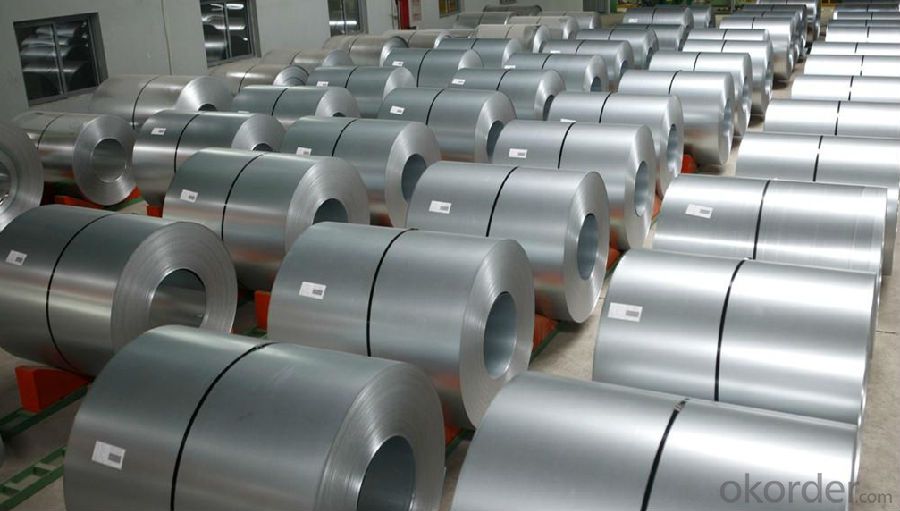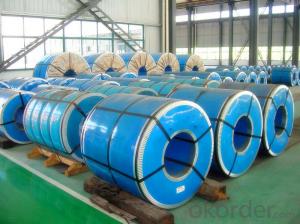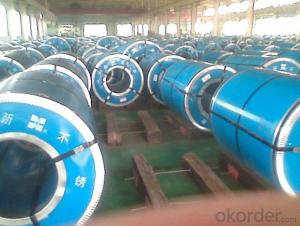Stainless Steel Coil 304 Cold Rolled Surface 2B with High Quality
- Loading Port:
- Guangzhou
- Payment Terms:
- TT OR LC
- Min Order Qty:
- 100 m.t.
- Supply Capability:
- 20000 m.t./month
OKorder Service Pledge
OKorder Financial Service
You Might Also Like
1.Structure of Stainless Steel Coil Cold Rolled 304 With Good Quality
Cold Rolled stainless steel Coil with good quality is one of the raw material of the cold rolled stainless steel Coil,
which can be used directly in many places. Stainless Steel (Stainless Steel) is short for acid proof Stainless Steel, resistant to weak corrosive medium such as air, steam, water, or with a Stainless Steel grade.
2.Main Features of Prefabricated Steel Structure High Building Project
Corrosion resistance The vast majority of stainless steel products for corrosion resistant performance is good, like a, 2 kinds of tableware,
kitchen utensils and appliances, water heaters, water dispensers, etc., some foreign businessmen on corrosion resistance of products
also do experiment: in NACL aqueous solution heated to boiling, after a period of time the best solution, wash and drying, weight loss,
to determine the degree of corrosion (note: the product polishing, because of the sand cloth or sandpaper containing Fe, will cause the
test surface rust spots)
3. Stainless Steel Coil Cold Rolled 304 With Good Quality Images


4. Stainless Steel Coil Cold Rolled 304 With Good Quality Specification
The word "stainless steel" is not merely refers to a pure stainless steel, but said more than one hundred kinds of stainless steel
industry, the development of each stainless steel has good performance in their specific applications. The key to the success of
the first is to make clear purpose, and then determine the correct material. Related to architectural construction applications usually
only six types of steel. They contain 17 ~ 22% chromium, good steel contains nickel. Add molybdenum can further improve the
atmospheric corrosion resistance, especially containing chloride atmospheric corrosion resistance. Stainless steel often according
to the state of organization can be divided into: martensite steel, ferritic steel, austenitic steel, austenitic (twophase) - ferrite stainless
steel and precipitation hardening stainless steel, etc. In addition, according to ingredients can be divided into: chromium stainless
steel, chromium nickel stainless steel and chromium manganese nitrogen stainless steel, etc.
5. Applications of Stainless Steel Coil 304 With Good Quality
1. Kitchenware: tableware, cookware, Stoves…
2. Food packing: storage cans, food containers…
3. Construction: bridge, roofing, wall, decoration, bathroom accessories…
4. Precision instruments: electrical products, aerospace…
5. Others: automotive parts, machine building, chemical processing, farming…
6.FAQ of Stainless Steel Coil 304 With Good Quality
We have organized several common questions for our clients,may help you sincerely:
①How about your company?
A world class manufacturer & supplier of castings forging in carbon steel and alloy steel,is one of the large-scale professional investment casting production bases in China,consisting of both casting foundry forging and machining factory.
Annually more than 8000 tons Precision casting and forging parts are exported to markets in Europe,America and Japan. OEM
casting and forging service available according to customer’s requirements.
②How to guarantee the quality of the products?
We have established the international advanced quality management system,every link from raw material to final product we have strict
quality test;We resolutely put an end to unqualified products flowing into the market. At the same time, we will provide necessary
follow-up service assurance.
③How is the packaging and delivery?
Standard export packing (Coil: waterproof paper + protective steel ring; Circle: wooden box), or as your requirement and the delivery term
is based on the project.
④How long can we receive the product after purchase?
In the purchase of product within 20 working days, We will arrange the factory delivery as soon as possible. The specific time of receiving
is related to the state and position of customers. Commonly 20 to 40 working days can be served.
- Q:Can stainless steel strips be used for metal stamping?
- Yes, stainless steel strips can be used for metal stamping. Stainless steel is a popular choice for metal stamping due to its high strength, corrosion resistance, and durability. It is commonly used for various applications such as automotive parts, appliances, and electrical components. Stainless steel strips can be easily formed, bent, and stamped into different shapes and sizes using metal stamping techniques. The characteristics of stainless steel, such as its hardness and resistance to wear, make it suitable for producing precise and intricate designs through metal stamping processes. Overall, stainless steel strips are a versatile material that can be effectively utilized for metal stamping purposes.
- Q:Are stainless steel strips suitable for medical equipment?
- Yes, stainless steel strips are indeed suitable for medical equipment. Stainless steel is a popular material used in the manufacturing of medical equipment due to its exceptional properties. First and foremost, stainless steel is highly resistant to corrosion, making it ideal for medical devices that are exposed to bodily fluids and sterilization processes. It also has excellent strength and durability, allowing the equipment to withstand the rigors of daily use. Additionally, stainless steel is non-reactive, meaning it does not leach any harmful chemicals or substances into the patient's body. This makes it a safe and hygienic choice for medical applications. Furthermore, stainless steel is easy to clean and maintain, ensuring a high level of cleanliness and preventing the growth of bacteria. Overall, stainless steel strips offer the necessary qualities required for medical equipment, making them a suitable choice in the healthcare industry.
- Q:Can stainless steel strips be used in packaging machinery?
- Packaging machinery can utilize stainless steel strips effectively. Stainless steel, a versatile and long-lasting material, finds widespread use in machinery and equipment, including packaging machinery. Its exceptional resistance to corrosion, high temperature, and wear make it well-suited for diverse packaging applications. When integrated into packaging machinery, stainless steel strips enable tasks such as cutting, sealing, and forming packaging materials. Moreover, stainless steel's sleek surface and convenient cleaning properties make it an optimal choice for upholding hygiene and preventing contamination during the packaging process. In summary, stainless steel strips present a dependable and efficient solution for utilization in packaging machinery.
- Q:Are stainless steel strips suitable for cryogenic valves?
- Indeed, cryogenic valves can indeed benefit from the utilization of stainless steel strips. Renowned for its remarkable capacity to endure extremely low temperatures, stainless steel is widely employed in cryogenic scenarios. This material boasts a commendable ratio of strength to weight, excellent thermal conductivity, and outstanding resistance to corrosion, rendering it highly suitable for integration into cryogenic systems. Moreover, the versatility of stainless steel strips allows for their fabrication into diverse shapes and sizes, affording flexibility in the design of cryogenic valve components. In sum, stainless steel strips emerge as a dependable and long-lasting option for cryogenic valves.
- Q:Are 111 stainless steel strips suitable for food processing equipment?
- Food processing equipment can benefit from the use of 111 stainless steel strips, as they possess excellent corrosion resistance, strength, and hygienic properties. The widely utilized stainless steel material is known for its versatility in the food industry. Grade 304 stainless steel, also referred to as the 111 stainless steel grade, is particularly popular in food processing equipment due to its outstanding resistance to corrosion caused by acids, alkalis, and other chemicals commonly found in food processing environments. Another advantage is that Grade 304 stainless steel is non-porous, making it effortless to maintain high levels of hygiene by ensuring easy cleaning. Therefore, opting for 111 stainless steel strips would be a suitable decision for food processing equipment.
- Q:How do stainless steel strips perform in corrosive marine environments?
- Stainless steel strips possess a high resistance to corrosion and exhibit exceptional performance in corrosive marine settings. Their unique composition, consisting of chromium, nickel, and other alloying elements, enables the formation of a protective oxide layer on the surface. This layer acts as a barrier, effectively shielding the strips from corrosive elements like saltwater, moisture, and atmospheric conditions encountered in marine environments. The corrosion-resistant nature of stainless steel strips makes them highly suitable for various marine applications, including boat fittings, marine hardware, offshore platforms, and underwater structures. They are capable of enduring the harsh conditions of saltwater, waves, and high humidity without compromising their structural integrity or aesthetic appeal. Moreover, stainless steel strips offer excellent resistance against pitting and crevice corrosion, which are prevalent forms of corrosion in marine settings. This characteristic ensures their long-term durability and reliability, even in highly corrosive conditions. In addition, stainless steel strips are easy to clean and maintain as they do not require any additional coatings or treatments to protect against corrosion. Regular cleaning with fresh water is typically sufficient to maintain their excellent condition. In conclusion, stainless steel strips are an ideal choice for corrosive marine environments due to their exceptional resistance to corrosion, strength, and durability. They provide a cost-effective and reliable solution that can withstand the challenges posed by the marine environment, ensuring long-lasting performance.
- Q:Are 111 stainless steel strips resistant to intergranular corrosion?
- Yes, 111 stainless steel strips are resistant to intergranular corrosion. 111 stainless steel is a type of austenitic stainless steel that contains high levels of chromium and nickel, which provide excellent resistance to corrosion. The intergranular corrosion resistance of stainless steel is determined by its carbon content and the presence of stabilizing elements such as titanium or niobium. 111 stainless steel strips typically have low carbon content, which helps prevent the formation of chromium carbide precipitates along the grain boundaries, thus reducing the susceptibility to intergranular corrosion. Additionally, the high chromium and nickel content in 111 stainless steel promote the formation of a protective oxide layer on the surface, further enhancing its resistance to corrosion. Therefore, 111 stainless steel strips are generally considered to be highly resistant to intergranular corrosion.
- Q:What are the mechanical properties of stainless steel strips?
- Stainless steel strips are highly sought after for various applications due to their range of mechanical properties. One key property is their exceptional strength, with a tensile strength typically ranging from 500-1000 MPa. This strength allows them to withstand heavy loads without breaking or bending. Another important property of stainless steel strips is their impressive resistance to corrosion. The presence of chromium in the steel forms a protective oxide layer on the surface, preventing rusting and corrosion in most environments. This corrosion resistance makes them suitable for use in harsh conditions like marine environments and chemical processing plants. Stainless steel strips also possess excellent ductility, meaning they can be easily shaped without fracturing. This makes them ideal for applications that require complex or intricate designs. Additionally, their high fatigue strength enables them to endure repeated loading and unloading cycles without failure, making them suitable for applications involving cyclic or dynamic loading. Furthermore, stainless steel strips have excellent thermal conductivity, making them efficient heat conductors. This property makes them suitable for use in heat exchangers and cookware. They also have a relatively low coefficient of thermal expansion, reducing the risk of warping or distortion when exposed to temperature changes. In conclusion, stainless steel strips offer high strength, excellent corrosion resistance, good ductility, high fatigue strength, good thermal conductivity, and a low thermal expansion coefficient. These properties make them versatile and widely used in various industries, including automotive, construction, aerospace, and manufacturing.
- Q:Are stainless steel strips suitable for furnace parts?
- Indeed, furnace parts find stainless steel strips to be highly suitable. Renowned for its remarkable resistance to corrosion, heat, and oxidation, stainless steel emerges as an impeccable material for furnace components that endure extreme temperatures. These strips boast exceptional strength and durability, guaranteeing the endurance of furnace parts. Moreover, stainless steel's non-reactive properties render it compatible with diverse types of furnaces, spanning industrial, commercial, and residential applications. All in all, stainless steel strips stand as a dependable and effective option for furnace parts.
- Q:Are stainless steel strips suitable for cryogenic applications?
- Indeed, cryogenic applications find stainless steel strips to be appropriate. Renowned for their remarkable mechanical properties, corrosion resistance, and thermal stability, stainless steel is favored across diverse sectors, particularly cryogenics. Stainless steel strips exhibit the capability to endure frigid temperatures sans compromising their structural integrity or succumbing to brittleness, an indispensable trait in cryogenic settings. Additionally, stainless steel boasts non-magnetic attributes and low thermal conductivity, both highly desirable in cryogenic applications that necessitate minimal heat transfer and magnetic interference. In summary, stainless steel strips emerge as a dependable and long-lasting choice for deployment within cryogenic applications.
1. Manufacturer Overview |
|
|---|---|
| Location | |
| Year Established | |
| Annual Output Value | |
| Main Markets | |
| Company Certifications | |
2. Manufacturer Certificates |
|
|---|---|
| a) Certification Name | |
| Range | |
| Reference | |
| Validity Period | |
3. Manufacturer Capability |
|
|---|---|
| a)Trade Capacity | |
| Nearest Port | |
| Export Percentage | |
| No.of Employees in Trade Department | |
| Language Spoken: | |
| b)Factory Information | |
| Factory Size: | |
| No. of Production Lines | |
| Contract Manufacturing | |
| Product Price Range | |
Send your message to us
Stainless Steel Coil 304 Cold Rolled Surface 2B with High Quality
- Loading Port:
- Guangzhou
- Payment Terms:
- TT OR LC
- Min Order Qty:
- 100 m.t.
- Supply Capability:
- 20000 m.t./month
OKorder Service Pledge
OKorder Financial Service
Similar products
New products
Hot products
Hot Searches
Related keywords





























